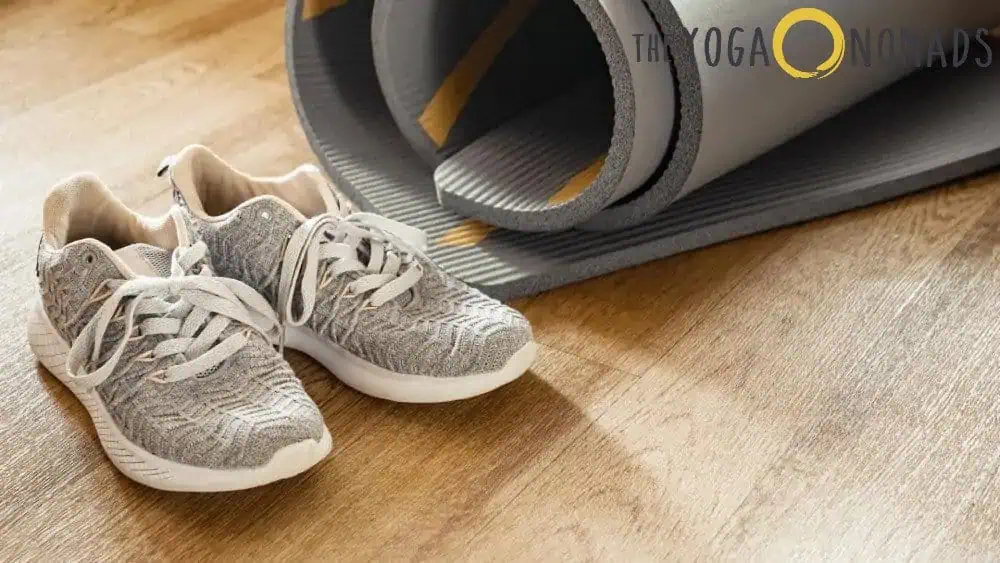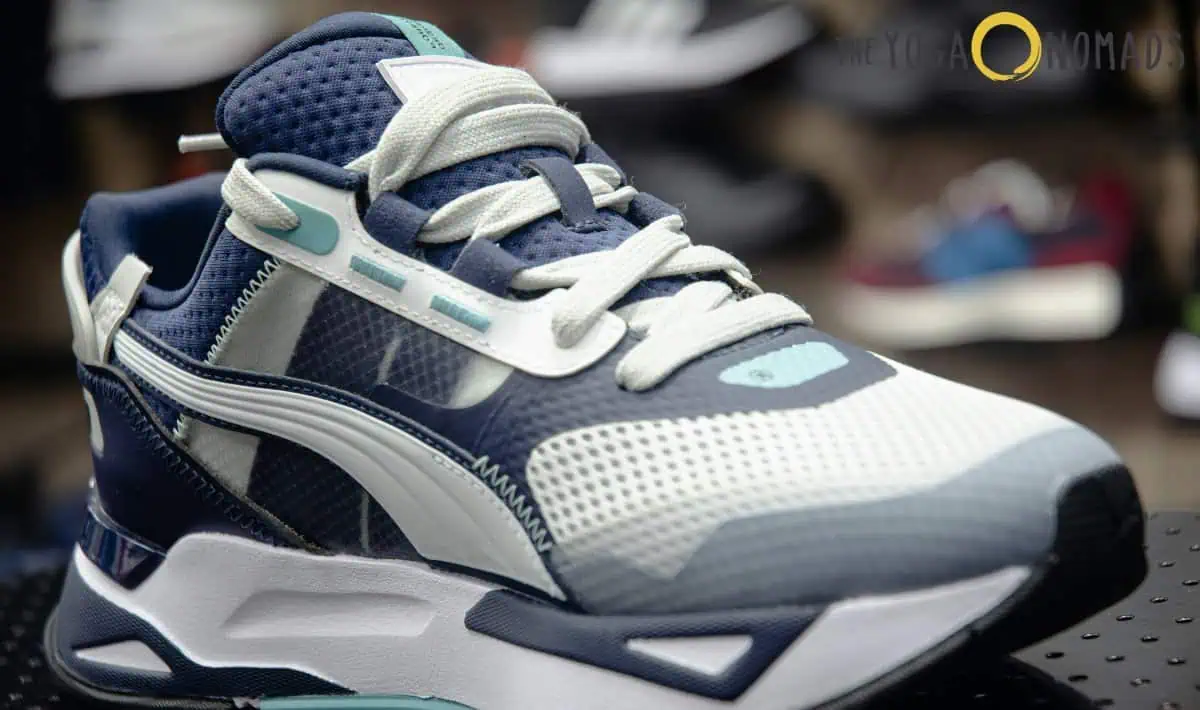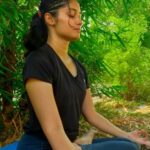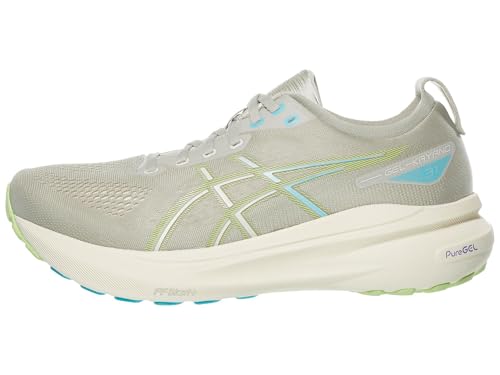Key Takeaways
Discover the top three supportive footwear options that alleviate joint pain during yoga.
Yoga is frequently done barefoot, but supportive shoes can be a huge help for people who have joint pain, particularly in the knees or ankles. Sore joints require protection that begins at the base, whether you’re holding a grounding warrior posture or flowing through a mild vinyasa. Without interfering with your natural range of motion, the perfect yoga shoes provide the perfect balance of cushioning, traction, and modest arch support.
The keys to comfort and control are snug fitting, soft soles, and open-toe designs. The correct socks or shoes can make all the difference. They help you move more steadily and easily, in addition to lessening the strain on your joints.
Let’s explore some of the best options of footwear to support your joints!
Contents
- 1 Top Footwear Choices for Yoga Joint Pain
- 2 1. Hoka One One Bondi 7
- 3 2. ASICS Gel-Kayano 28
- 4 Conclusion
- 5 Frequently Asked Questions
- 5.1 What features should I look for in yoga footwear for joint pain?
- 5.2 Are Hoka One One Bondi 7 shoes good for joint pain during yoga?
- 5.3 Is it better to practice yoga barefoot or with supportive shoes?
- 5.4 How does the ASICS Gel-Kayano 28 help with joint pain in yoga?
- 5.5 Can New Balance Fresh Foam 1080v11 help with knee pain in yoga?
- 5.6 Are there risks to wearing shoes during yoga?
- 5.7 When should I consult a doctor about joint pain and yoga footwear?
- 5.8 Was this helpful?
Top Footwear Choices for Yoga Joint Pain

Contrary to popular belief, not all yogis prefer to be barefoot! For some people — especially those with arthritis or joint pain — a little extra padding and support on the feet can make or break a successful yoga practice. Wearing the proper footwear makes yoga easier and more supportive by relieving pressure on the knees, ankles, and hips.
Types of Yoga Footwear
Depending on the level of support needed, there are many options for yoga footwear out there!
Yoga socks or pilates slippers have silicone grips on their soles and provide just enough cushioning for your arches and toes if you’re looking for a bit more comfort and grip. Some even feature memory foam soles, which are just thick enough to relieve pressure on hard flooring.
For people with more severe joint issues like arthritis or plantar fasciitis, actual sneakers are the way to go. Luckily, they don’t have to be heavy and bulky.
Look for shoes with a large toe box and some arch support to help relieve strain on the knees and ankles. For additional support, you might even insert your own orthotics into some designs that even have detachable insoles.
A few tips I’ve learned the hard way:
- Size up half a size if your feet tend to swell.
- Choose breathable materials for sweaty sessions.
- Avoid shoes with rough seams or tight bands.
- And if you can, test them out in a few poses before buying.
Lastly, if you have chronic joint pain, it’s worth talking to a doctor or physical therapist. They can help you figure out the right level of support for your body. For me, finding the right footwear transformed yoga from a struggle to something I genuinely enjoy. With less pain and more stability, I stay on the mat longer and feel better doing it.
1. Hoka One One Bondi 7

Plush comfort and shock support make the Bondi 7 unique, especially for those who enjoy yoga exercises. My first walk in there was like walking on soft, springy turf, instead of just pavement. The thick, cushy bottom sole lets me baby my knee and ankle joints while going for a walk after my yoga session. People living with joint pain understand that the cumulative touch—such as a soft landing—makes all the difference.
For example, since wearing the Bondi 7, I have experienced less soreness when standing on my feet for longer periods.
HOKA ONE ONE Bondi 7
See latest priceReliable Cushioning for Achy Joints
Underfoot, the Bondi 7 features a full-length EVA midsole. What this means for my joints is simple: each step feels less jarring. Instead of the ground making a hard impact on my foot, my foot is landing on a cloud that springs back. For a person with painful knees or delicate hips, this difference means increased comfort on long walks or simple trips to the car.
The wide base makes my feet feel super planted, even when I’m running or walking with a big load. Whether out on errands or a slow, snowy trail walk, their plush support has always impressed me.
Roomy Fit and Soft Upper
The toe box is wide and very rounded. My toes have space to spread out, which keeps pressure off painful areas. The upper is this dreamy, padded soft mesh that cradles my foot and doesn’t crush it. Even post-power yoga, puffy feet are welcome without pinching.
I’ve worn these with thin socks or barefoot, and it always feels perfect. For runners who have bunions or wide feet, this foot shape translates to fewer blisters and less flagrant rubbing.
Secure Heel and Versatile Use
The Bondi 7 has 360 degrees of memory foam collar around the heel. The added padding hugs my ankle tightly, which keeps me in place, and there’s no slippage. Especially after a yoga class, that’s a comfort when I’m seeking out some sure-footedness.
The outsole did exceptionally well on gym floors and sidewalks. I move easily from indoor classes to outdoor walks without changing shoes and I never find myself concerned about slipping. The shoes are hefty, going over the scales at around 10.7 ounces, but they’re stable rather than clunky.
2. ASICS Gel-Kayano 28

Putting on the Gel-Kayano 28, I notice that soft cushion immediately. The key gel technology located in the heel helps absorb the impact of every step. This cushion is great for providing relief from knee and ankle pain. People who suffer from arthritis are all too familiar with the pain caused by unsupportive, ultra-thin outsoles.
These shoes provide plush, bouncy landings—even after an all-day walk or a long day close to the ground on my feet! For yoga, quick errands, or a leisurely post-class walk, my joints are eternally grateful when I choose these.
ASICS Gel-Kayano 28
See latest priceSupport That Stays Steady
The arch support is what draws attention. With the supportive midsole, my feet don’t shift around, so I feel secure. It’s accommodating for all foot types—those with flat feet and high arches alike.
I’ve used them both for mellow yoga flows and while running around town post-practice. I notice my posture feels more locked in, and pains from former foot injuries are kept at bay. The heel clutch system hugs the back of my foot so there’s no slipping, which eases stress on my Achilles tendon and ankles.
Friends who wear orthotics have sworn by the roomy interior, perfect for accommodating their inserts.
Breathable and Lightweight
Even after a long day, my feet don’t feel hot and gross. The engineered mesh upper keeps the air circulating, so I don’t find myself with that swamp foot when I step out of class or into those hot rooms.
Some sneakers end up feeling bulky or clunky — but not these. Unlike other training shoes, I can pack these in a gym bag without them taking up too much space. When I go on yoga retreats, you can bet these shoes are in my suitcase, too!
Durable for Daily Use
The sleek outsole grips exceptionally well on wet or smooth floors. No more worrying about sliding around post-sweaty class or in the locker room. The grip pattern lends itself to stability, even if I am just standing in a tree pose or walking out of the car.
I’ve had my pair for a couple of months now, and they certainly stand up to the rigors of everyday use. No indications yet of the sole thinning out or the mesh ripping.
3. New Balance Fresh Foam 1080v11

Fresh Foam 1080v11 is the benchmark for cushy comfort and reliable support straight from the box. By the end of a full week of classes, my knees are frequently sore and stiff. It’s as though slipping into these shoes now means my joints get a break.
The underfoot cushion is like running on a thick yoga mat—but springier. I feel less pound-ish in my arches and ankles, even when walking around on hard-core city concrete or wood studio floors.
New Balance Fresh Foam 1080
See latest priceCushioning That Eases Joint Pressure
The biggest attraction is the Fresh Foam midsole. While the foam is soft, it’s not mushy making for a much lighter feel with each step. Even after a day spent running errands, my heels are happy.
Not to mention that after a long day on my feet, the balls of my feet still feel great! With this accommodating foam, you’ll feel the difference.
On studio days, I wear these before and after class, and have found they keep my hips very loose. For those of us who are still playing through some chronic sports injuries, that cushion is a joint-saving luxury.
Roomy Toe Box for Natural Motion
The fit overall is great; the toe box is a nice wide enough width where my toes can splay and spread out. In these shoes, I never feel cramped or pinched—even after 10 hours on my feet.
When my joint pain flares, tight shoes aggravate the situation, but the 1080v11 has enough room that when my feet start swelling, they can move freely. I’ve worn these with even thicker yoga socks and still had plenty of comfy wiggle room.
For people who suffer from bunions or have wider feet, the spacious build is a welcome relief.
Breathable and Lightweight Build
The soft knit upper allows for good airflow to minimize sweat and keep your feet nice and cool during those summer runs. I can wear these on the deck in Megaformer or running errands and feel grounded vs overly cushioned.
The mesh actually moves with my foot so even having the usual post-practice swelling doesn’t create an issue in the fit of the shoe. On those long travel days, I am never paranoid about receiving a blister or chafing.
Reliable Grip and Support
The outsole is super flexible and grips great on studio floors, gym mats and even on wet pavement. Between walking to classes downtown, the full contact grip tread keeps me sure footed.
The heel cup wraps around my foot, so my ankle is supported and secure. If you’re looking for a bit more cushioning to help wobbly joints, these shoes offer a lot of protection.
I’ve done yoga warmups, everyday walks, and some run-walk intervals without any sliding.
Key Benefits at a Glance:
- Deep Fresh Foam cushion for less joint stress
- Wide toe box for comfort and natural spread
- Breathable mesh upper keeps feet cool
- Secure grip on studio and outdoor surfaces
Conclusion
When doing yoga with achy joints, wearing the right shoes is crucial. These days, I really enjoy putting on shoes with actual cushioning, like the Hoka Bondi 7 or New Balance Fresh Foam. You can feel the support and grip they provide with each movement. Your knee joints will suffer no more!
Yes, if you’re seeking for additional support on the mat, select shoes that are comfortable for you and fit your specific needs. You deserve comfort that doesn’t quit. Make moving through life easy — both on and off the mat.
Check out our article on various yoga mats and props for joint pain.
Pop quiz! 🧘🤔
Proper footwear can help alleviate joint pain during yoga practice
Yoga is best practiced barefoot for maximum benefit, making footwear irrelevant.
Supportive footwear can improve balance and stability while practicing yoga, especially for those with joint pain
Frequently Asked Questions
What features should I look for in yoga footwear for joint pain?
Choose footwear with good ventilation, cushioning, and arch support, and good shock absorption. These elements work to alleviate pressure on your joints, providing more comfort while you practice yoga.
Are Hoka One One Bondi 7 shoes good for joint pain during yoga?
Yup, the Hoka One One Bondi 7 has maximum cushioning and stability. This further decreases impact on joints, making the best footwear for yoga with joint pain.
Is it better to practice yoga barefoot or with supportive shoes?
Joint pain doesn’t have to keep you from your yoga practice, and supportive shoes do wonders. They offer added shock absorption and support that helps alleviate pressure on delicate joints while in standing or balancing postures.
How does the ASICS Gel-Kayano 28 help with joint pain in yoga?
The ASICS Gel-Kayano comes with enduring gel cushioning and maximum arch support. This duo reduces shock on joints, assisting in managing pain throughout yoga practices.
Can New Balance Fresh Foam 1080v11 help with knee pain in yoga?
New Balance Fresh Foam 1080v11 is a great choice for soft foam cushioning. This reduces shock and reduces impact on your knees, helping ensure that yogis with painful knees can be as comfortable as possible practicing yoga.
Are there risks to wearing shoes during yoga?
If you’re doing something and wearing shoes, you lose the flexibility of the foot in poses. For people with joint pain, the pros of extra support usually trump the cons.
When should I consult a doctor about joint pain and yoga footwear?
If you have joint pain that doesn’t improve with home care or pain worsens, see a doctor. They are in the best position to prescribe the right footwear or form modifications that will help someone achieve a safe, comfortable yoga practice.





